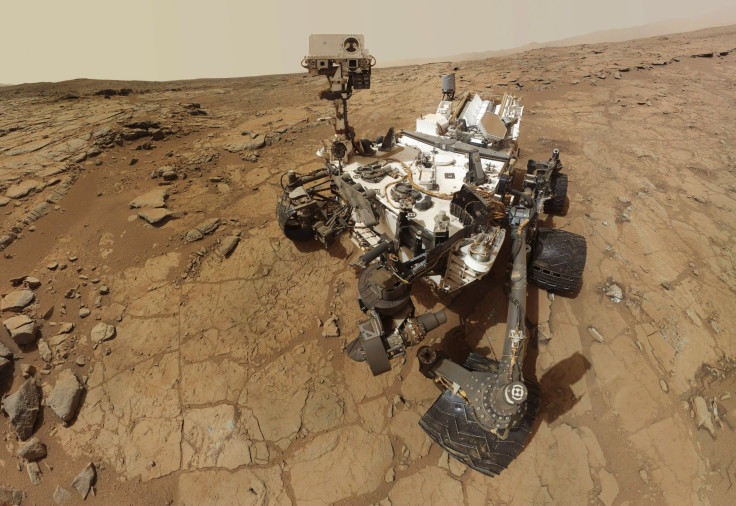Life On Mars? NASA Curiosity 'Sniffs' Methane Spike In Atmosphere, Finds Organic Molecules In Rock Sample

NASA announced Tuesday that its Mars Curiosity rover detected a "a tenfold spike in methane" in the atmosphere. Organic molecules were also detected in a rock sample collected by the rover. Curiosity was "sniffing" the atmosphere using its Sample Analysis at Mars (MARS) scientific suite, which detected increased methane in 2013 and again in 2014.
There are several biological and nonbiological sources that could be responsible for the methane spike, NASA reported. Microbes could be a biological source while methane could also be created through an interaction between olivine, a type of rock, and water. Four methane spikes were detected in 2013 and 2014. Preserved organic molecules were also found in a powdered rock sample collected by Curiosity.
A change in the air: I detected a 10x spike of methane in Mars' atmosphere #AGU14 http://t.co/TsMs5LEW8b pic.twitter.com/v71ei8XDAx
— Curiosity Rover (@MarsCuriosity) December 16, 2014"This temporary increase in methane -- sharply up and then back down -- tells us there must be some relatively localized source. There are many possible sources, biological or non-biological, such as interaction of water and rock," Sushil Atreya of the University of Michigan, Ann Arbor, a member of the Curiosity rover science team, said in a statement.

The latest findings from Curiosity do not prove Mars once had life, but it is the first time methane was detected in the atmosphere by Curiosity and indicates active chemistry on the planet, while the organic compounds found in the rock sample indicate favorable conditions in Mars' history.
"Can we learn more about the active chemistry causing such fluctuations in the amount of methane in the atmosphere? Can we choose rock targets where identifiable organics have been preserved?" John Grotzinger, Curiosity project scientist of the California Institute of Technology in Pasadena, said in a statement.
NASA will conduct further analysis to determine the type of organic compounds found in the rock sample, but the results could provide new insights into the history of water on Mars and changes to the Martian environment. Mars lost most of its water billions of years ago and researchers can determine these changes by comparing the deuterium-hydrogen ratio found in water preserved in rock samples to the ratio found in water found in the atmosphere. Hydrogen is lighter and escapes into the atmosphere quicker than deuterium. The rock sample was formed 3.9 billion to 4.6 billion years ago, notes NASA.
"The ratio that Curiosity found in the Cumberland sample is about one-half the ratio in water vapor in today's Martian atmosphere, suggesting much of the planet's water loss occurred since that rock formed. However, the measured ratio is about three times higher than the ratio in the original water supply of Mars, based on assumption that supply had a ratio similar to that measured in Earth's oceans. This suggests much of Mars' original water was lost before the rock formed," NASA explained.
Certified organics! I detected organics for the 1st time on the surface of Mars #AGU14 http://t.co/TsMs5LEW8b pic.twitter.com/AVk5Wxp5G0
— Curiosity Rover (@MarsCuriosity) December 16, 2014Last week, data collected by Curiosity helped determine that Mount Sharp was formed by sediment deposited at the bottom of a large lake. A Martian meteorite that crashed into Earth in July 2011 also held some possible evidence of a once habitable Mars.
© Copyright IBTimes 2024. All rights reserved.






















